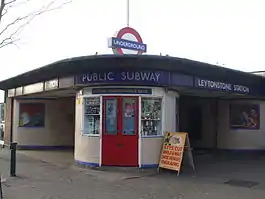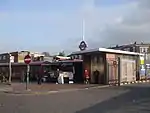Leytonstone tube station
Leytonstone is a London Underground station in Leytonstone in London, England. It is on the Central line, on the boundary of Zones 3 and 4. Towards Central London the next station is Leyton, while going east from Leytonstone, the line divides into two branches. On the direct route to Woodford and Epping the next stop is Snaresbrook, and on the Hainault loop it is Wanstead.
| Leytonstone | |
|---|---|
 Eastern entrance on Church Lane | |
 Leytonstone Location of Leytonstone in Greater London | |
| Location | Leytonstone |
| Local authority | London Borough of Waltham Forest |
| Managed by | London Underground |
| Number of platforms | 3 |
| Fare zone | 3 and 4 |
| OSI | Leytonstone High Road |
| London Underground annual entry and exit | |
| 2015 | |
| 2016 | |
| 2017 | |
| 2018 | |
| 2019 | |
| Railway companies | |
| Original company | Eastern Counties Railway |
| Pre-grouping | Great Eastern Railway |
| Post-grouping | London and North Eastern Railway |
| Key dates | |
| 22 August 1856 | Opened |
| 5 May 1947 | Central line service introduced |
| 1 September 1955 | Goods yard closed[5] |
| Other information | |
| External links | |
| WGS84 | 51.5683°N 0.0083°E |
History
The railway line from Loughton Branch Junction (on the Lea Valley line between Stratford and Lea Bridge) to Loughton was built by the Eastern Counties Railway, and opened on 22 August 1856.[6] A station at Leytonstone was opened on the same day.[7] In turn it became, from 1862, part of the Great Eastern Railway system and then in 1923 part of the London & North Eastern Railway before being transferred to London Transport in 1947. This formed part of the "New Works Programme 1935 – 1940" that was to see major changes at Leytonstone with the station becoming the junction of the existing Loughton-Epping-Ongar line, newly electrified, with the new tube tunnel running under Eastern Avenue towards Newbury Park. This work saw a complete reconstruction of the station along with the removal of the level crossing at Church Lane and its replacement by an underbridge. The work stopped in May 1940 due to wartime priorities; further delays were caused by the station buildings being hit by a German bomb in January 1944. During the war, the new tunnels were used as an aircraft component factory; the part closest to Leytonstone was a public air-raid shelter.[8]
The station was first served by the Central line on 5 May 1947 when it became the temporary terminus of the line, passengers changing on to steam shuttle onwards to Epping. This ceased on 14 December 1947 with the extension of Underground services to Woodford and Newbury Park.
Notable events
- In honour of the centenary of the birth of film director Sir Alfred Hitchcock (born 13 August 1899 in Leytonstone), the London Borough of Waltham Forest commissioned the Greenwich Mural Workshop to create a series of mosaics of Hitchcock's life and works in the tube station. Work was started in June 2000 and the mosaics were unveiled on 3 May 2001.[9]
- Three people were injured inside the station's ticket hall during the evening of 5 December 2015, with one suffering serious knife injuries. The Metropolitan Police arrested the attacker inside the station after using Tasers against him.[10] Video footage later emerged of the attacker repeatedly shouting "this is for Syria". A remark shouted at the attacker by a witness, "You ain’t no Muslim, bruv”, resulted in considerable media comment and was subsequently praised by the then Prime Minister, David Cameron.[11]
Today
The station has three platforms. The centre platform is generally used for through services going westbound, but can be used to terminate trains from both directions. However, because of the configuration of the tracks, trains going eastbound from this platform can access only the Epping branch. Trains needing access to the Hainault branch can do so by shunting west of the station, and then running into the normal eastbound platform via a crossover.
Connections
London Buses routes 66, 145, 257, 339, W13, W14, W15, W16 and W19 and night route N8 serve the station and bus station.
Gallery
| Wikimedia Commons has media related to Leytonstone tube station. |
 The westbound platforms at Leytonstone, looking west
The westbound platforms at Leytonstone, looking west View of platforms
View of platforms Leytonstone junction, showing the diverge between Epping and Hainault branches, the latter diverging and heading underground
Leytonstone junction, showing the diverge between Epping and Hainault branches, the latter diverging and heading underground Western entrance facing Grove Green Road and bus stand.
Western entrance facing Grove Green Road and bus stand..jpg.webp) Hitchcock The Director
Hitchcock The Director
References
- "Out-of-Station Interchanges" (Microsoft Excel). Transport for London. 2 January 2016. Retrieved 28 August 2016.
- "Multi-year station entry-and-exit figures (2007–2017)" (XLSX). London Underground station passenger usage data. Transport for London. January 2018. Retrieved 22 July 2018.
- "Station Usage Data" (CSV). Usage Statistics for London Stations, 2018. Transport for London. 21 August 2019. Retrieved 27 April 2020.
- "Station Usage Data" (XLSX). Usage Statistics for London Stations, 2019. Transport for London. 23 September 2020. Retrieved 9 November 2020.
- Hardy, Brian, ed. (March 2011). "How it used to be – freight on The Underground 50 years ago". Underground News. London Underground Railway Society (591): 175–183. ISSN 0306-8617.
- Allen, Cecil J. (1956) [1955]. The Great Eastern Railway (2nd ed.). Hampton Court: Ian Allan. pp. 20, 216.
- Butt, R.V.J. (1995). The Directory of Railway Stations. Yeovil: Patrick Stephens Ltd. p. 142. ISBN 1-85260-508-1. R508.
- How the Railway Came to Leytonstone, Alan Simpson, Leyton & Leytonstone Historical Society 2006
- "Alfred Hitchcock mosaics, Leytonstone, London". www.thejoyofshards.co.uk. Retrieved 28 April 2020.
- "Leytonstone Tube station stabbing a 'terrorist incident'". BBC News.
- Gayle, Damien (7 December 2015). "David Cameron praises 'You ain't no Muslim, bruv' remark". www.theguardian.com. Guardian News and Media Limited. Retrieved 6 October 2017.
External links
- YouTube video of a train arriving on the eastbound platform
- Leytonstone Underground Station: Hitchcock Mosaic
- Early photograph of the original 1856 station, from Church Lane
| Preceding station | Following station | |||
|---|---|---|---|---|
| Central line | towards Epping |
|||
| Out of system interchange | ||||
| Preceding station | Following station | |||
towards Gospel Oak | Gospel Oak to Barking Line Transfer at: Leytonstone High Road | towards Barking |
||
| Historical railways | ||||
| Leyton Line and station open |
Great Eastern Railway Eastern Counties Railway Loughton branch |
Snaresbrook Line and station open | ||